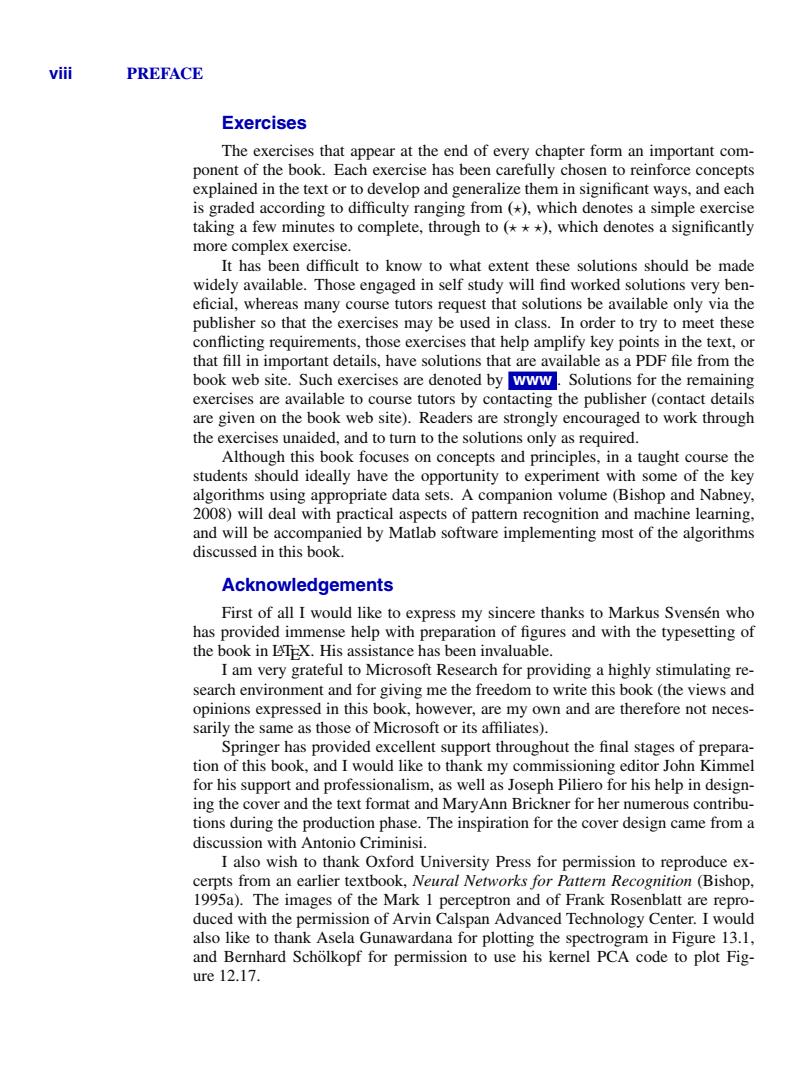正在加载图片...

viii PREFACE Exercises The exercises that appear at the end of every chapter form an important com- ponent of the book.Each exercise has been carefully chosen to reinforce concepts explained in the text or to develop and generalize them in significant ways,and each is graded according to difficulty ranging from ()which denotes a simple exercise taking a few minutes to complete,through to (**)which denotes a significantly more complex exercise. It has been difficult to know to what extent these solutions should be made widely available.Those engaged in self study will find worked solutions very ben- eficial,whereas many course tutors request that solutions be available only via the publisher so that the exercises may be used in class.In order to try to meet these conflicting requirements,those exercises that help amplify key points in the text,or that fill in important details,have solutions that are available as a PDF file from the book web site.Such exercises are denoted byww.Solutions for the remaining exercises are available to course tutors by contacting the publisher(contact details are given on the book web site).Readers are strongly encouraged to work through the exercises unaided,and to turn to the solutions only as required. Although this book focuses on concepts and principles,in a taught course the students should ideally have the opportunity to experiment with some of the key algorithms using appropriate data sets.A companion volume (Bishop and Nabney, 2008)will deal with practical aspects of pattern recognition and machine learning, and will be accompanied by Matlab software implementing most of the algorithms discussed in this book. Acknowledgements First of all I would like to express my sincere thanks to Markus Svensen who has provided immense help with preparation of figures and with the typesetting of the book in IATEX.His assistance has been invaluable. I am very grateful to Microsoft Research for providing a highly stimulating re- search environment and for giving me the freedom to write this book (the views and opinions expressed in this book,however,are my own and are therefore not neces- sarily the same as those of Microsoft or its affiliates). Springer has provided excellent support throughout the final stages of prepara- tion of this book,and I would like to thank my commissioning editor John Kimmel for his support and professionalism,as well as Joseph Piliero for his help in design- ing the cover and the text format and MaryAnn Brickner for her numerous contribu- tions during the production phase.The inspiration for the cover design came from a discussion with Antonio Criminisi. I also wish to thank Oxford University Press for permission to reproduce ex- cerpts from an earlier textbook,Neural Networks for Pattern Recognition (Bishop, 1995a).The images of the Mark 1 perceptron and of Frank Rosenblatt are repro- duced with the permission of Arvin Calspan Advanced Technology Center.I would also like to thank Asela Gunawardana for plotting the spectrogram in Figure 13.1, and Bernhard Scholkopf for permission to use his kernel PCA code to plot Fig- ure12.17.viii PREFACE Exercises The exercises that appear at the end of every chapter form an important component of the book. Each exercise has been carefully chosen to reinforce concepts explained in the text or to develop and generalize them in significant ways, and each is graded according to difficulty ranging from (⋆), which denotes a simple exercise taking a few minutes to complete, through to (⋆⋆⋆), which denotes a significantly more complex exercise. It has been difficult to know to what extent these solutions should be made widely available. Those engaged in self study will find worked solutions very beneficial, whereas many course tutors request that solutions be available only via the publisher so that the exercises may be used in class. In order to try to meet these conflicting requirements, those exercises that help amplify key points in the text, or that fill in important details, have solutions that are available as a PDF file from the book web site. Such exercises are denoted by www . Solutions for the remaining exercises are available to course tutors by contacting the publisher (contact details are given on the book web site). Readers are strongly encouraged to work through the exercises unaided, and to turn to the solutions only as required. Although this book focuses on concepts and principles, in a taught course the students should ideally have the opportunity to experiment with some of the key algorithms using appropriate data sets. A companion volume (Bishop and Nabney, 2008) will deal with practical aspects of pattern recognition and machine learning, and will be accompanied by Matlab software implementing most of the algorithms discussed in this book. Acknowledgements First of all I would like to express my sincere thanks to Markus Svensen who ´ has provided immense help with preparation of figures and with the typesetting of the book in LATEX. His assistance has been invaluable. I am very grateful to Microsoft Research for providing a highly stimulating research environment and for giving me the freedom to write this book (the views and opinions expressed in this book, however, are my own and are therefore not necessarily the same as those of Microsoft or its affiliates). Springer has provided excellent support throughout the final stages of preparation of this book, and I would like to thank my commissioning editor John Kimmel for his support and professionalism, as well as Joseph Piliero for his help in designing the cover and the text format and MaryAnn Brickner for her numerous contributions during the production phase. The inspiration for the cover design came from a discussion with Antonio Criminisi. I also wish to thank Oxford University Press for permission to reproduce excerpts from an earlier textbook, Neural Networks for Pattern Recognition (Bishop, 1995a). The images of the Mark 1 perceptron and of Frank Rosenblatt are reproduced with the permission of Arvin Calspan Advanced Technology Center. I would also like to thank Asela Gunawardana for plotting the spectrogram in Figure 13.1, and Bernhard Scholkopf for permission to use his kernel PCA code to plot Fig- ¨ ure 12.17